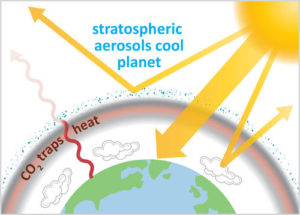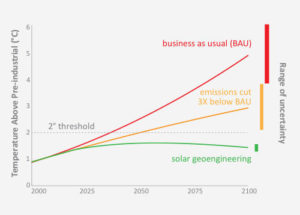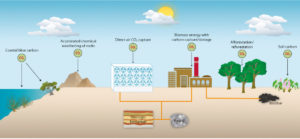ForumIAS announcing GS Foundation Program for UPSC CSE 2025-26 from 19 April. Click Here for more information.
Contents
- 1 Introduction
- 2 What is Geoengineering?
- 3 What is Solar Radiation Management/Modification (SRM) or Solar Geoengineering?
- 4 What is Greenhouse Gas Removal (GGR) or Carbon Geoengineering?
- 5 What is the need to focus on geoengineering?
- 6 What are the risks associated with geoengineering?
- 7 What are some of the geoengineering initiatives taken across the globe?
- 8 What can be the approach going ahead?
- 9 Conclusion
| For 7PM Editorial Archives click HERE → |
Introduction
Climate Change is no longer a myth and the adverse impacts of the phenomena are increasingly becoming evident. Anthropogenic interventions have significantly enhanced the magnitude and extent of climate change. With record-breaking heat waves hitting many parts of the world over the last few months, scientific circles have been hotly debating whether countries should prepare to deploy geoengineering technologies to deal with such climate emergencies.
| Read More: Heat Waves: Rising Frequency and Intensity – Explained, pointwise |
What is Geoengineering?
Geoengineering is an umbrella term for various experimental technologies. It refers to deliberate, large-scale intervention carried out in the Earth’s natural systems to reverse the impacts of climate change. They are slowly but steadily gaining salience and broadly fall under two categories: Solar Radiation Modification (SRM)/Radiative Forcing Geoengineering (RFG) and Carbon Dioxide Removal (CDR) technologies.
Source: Nature
What is Solar Radiation Management/Modification (SRM) or Solar Geoengineering?
SRM techniques aim to reflect a small proportion of the Sun’s energy back into space. This counters the temperature rise caused by increased levels of greenhouse gasses in the atmosphere which absorb energy and raise temperatures. Some proposed techniques include:
Albedo enhancement: Increasing the reflectiveness of clouds or the land surface so that more of the Sun’s heat is reflected back into space.
Space reflectors: Blocking a small proportion of sunlight before it reaches the Earth.
Stratospheric Aerosol Injection (SAI): Introducing small, reflective particles into the upper atmosphere to reflect some sunlight before it reaches the surface of the Earth.

Souce: harvard.edu
Cirrus Cloud Thinning: It focuses on eliminating or thinning cirrus clouds to allow heat to escape into space. These clouds are found at high altitudes, and often absorb more sunlight than they reflect.
What is Greenhouse Gas Removal (GGR) or Carbon Geoengineering?
GGR techniques aim to remove carbon dioxide or other greenhouse gases from the atmosphere. It directly counters the increased greenhouse effect and ocean acidification. Some proposed techniques include:
Afforestation: Engaging in a global-scale tree planting effort.
Biochar: ‘Charring’ biomass and burying it so that its carbon is locked up in the soil.
Bio-energy with carbon capture and sequestration: Growing biomass, burning it to create energy and capturing and sequestering the carbon dioxide created in the process.
Ambient Air Capture: Building large machines that can remove carbon dioxide directly from ambient air and store it elsewhere.
Ocean Fertilization: Adding nutrients to the ocean in selected locations to increase primary production which draws down carbon dioxide from the atmosphere.
Enhanced Weathering: Exposing large quantities of minerals that will react with carbon dioxide in the atmosphere and storing the resulting compound in the ocean or soil.
Ocean Alkalinity Enhancement: Grinding up, dispersing, and dissolving rocks such as limestone, silicates, or calcium hydroxide in the ocean. This will increase the ocean’s ability to store carbon and directly ameliorate ocean acidification.
Source: Center for Climate Engagement, University of Cambridge
What is the need to focus on geoengineering?
First, several modeling studies indicate that geoengineering might reduce some of the worst effects of climate change, such as lowering the warming and reducing the frequency of heatwaves and high-intensity storms.
Second, techniques like the stratospheric aerosol injection (SAI) are so affordable that a few dozen countries can easily deploy this technology unilaterally.
Third, it is becoming increasingly evident that the present trajectory of emissions cut may not be able to prevent the catastrophic impacts of climate change. Geoengineering technologies may be able to provide a quick solution, thus providing more time to shift away from fossil fuels.
What are the risks associated with geoengineering?
First, many experts fear that it may impair the self regulation capacity of natural ecosystems thereby doing more harm in the long run.
Second, they may distract attention from the need for deep cuts to gross emissions which is achievable with the right political will and resource mobilization. Such measures thus pose pivotal problems of intergenerational justice
Third, the impacts will not be limited to national borders. For instance, unilateral use of SAI could lead to significant adverse effects in other countries, leading to conflicts. Similarly if governments ever gain control of changing the course of potentially damaging storms, diversions that direct storms toward other countries may be seen as acts of war.
Fourth, the unintended consequences could include an adverse impact on rainfall, crop production and ocean acidification. Large-scale spraying of aerosols into the atmosphere could also deplete the ozone layer, enlarging the ozone hole. Another big risk is that when the aerosol injection is terminated abruptly this will cause rapid warming, disrupting the water cycle and leading to massive biodiversity loss. The impacts of such a “termination shock” would be much worse than the effects of climate change such measures aim to avoid.
Fifth, there is also an ethical argument that ‘do we have the right to manage and manipulate nature?’
The IPCC’s 5th Assessment Report observed that, “SRM techniques entail numerous uncertainties, side effects, risks and shortcomings” and “raise questions about costs, risks, governance and ethical implications of development and deployment“.
What are some of the geoengineering initiatives taken across the globe?
China has been implementing one of the world’s largest weather-modification programmes to artificially enhance rain. It plans to expand capacity to cover nearly 60% of the country by 2025.
The University of Cambridge created the Centre for Climate Repair last year to develop new methods for SRM and cloud brightening.
The Australian government has been testing marine cloud brightening to cool water temperatures near the Great Barrier Reef.
In India, cloud seeding has been tried in states such as Tamil Nadu, Karnataka and Maharashtra during droughts.
Enhanced Oil Recovery (EOR) and Carbon Capture in India is primarily being deployed for additional oil recovery from aged fields and fields with heavy oil such as in the Cambay and Barmer fields.
What can be the approach going ahead?
First, countries can focus on technologies that have surpassed the ideation stage and reached the experimentation stage like Stratospheric aerosols injection (SAI). SAI aims to mimic large volcanic eruptions that have a cooling effect on the globe. For instance, the eruption of Mount Pinatubo in the Philippines in 1991 caused global cooling of 0. 6°C for the following two years. However, cautious approach is advisable. There should be numerous short-scale experiments before scaling up the process for a widespread application.
Second, a lot more research is required to understand the impacts of geoengineering on the broader regional ecosystem. Further, there is a need for international cooperation among educational and research institutes.
Third, India needs to play a major role in framing global governance around the use of geoengineering technologies. These technologies have global ramifications and must be governed by an international rules-based system.
Fourth, geoengineering cannot be treated as a license to continue emitting more GHGs with no changes to current consumption and production patterns. Specific technologies that can help us achieve negative emissions need to be publicly funded (most obviously through the diversion of fossil fuel subsidies).
Conclusion
While geoengineering is highly risky, some experts argue that countries will deploy it if they fear large-scale casualties or economic disruptions due to extreme climatic events. In fact, considering the current trajectory of Earth’s warming, countries will have to make these choices within a decade or two. So Governments should start discussions on establishing global governance mechanism to deter the unilateral deployment of these technologies, while supporting further research on the evolving technologies. However, geoengineering can only act as a supplement to scaling back of GHG emissions in all sectors, not a substitute.
Source: The Times of India, Down to Earth, MIT







